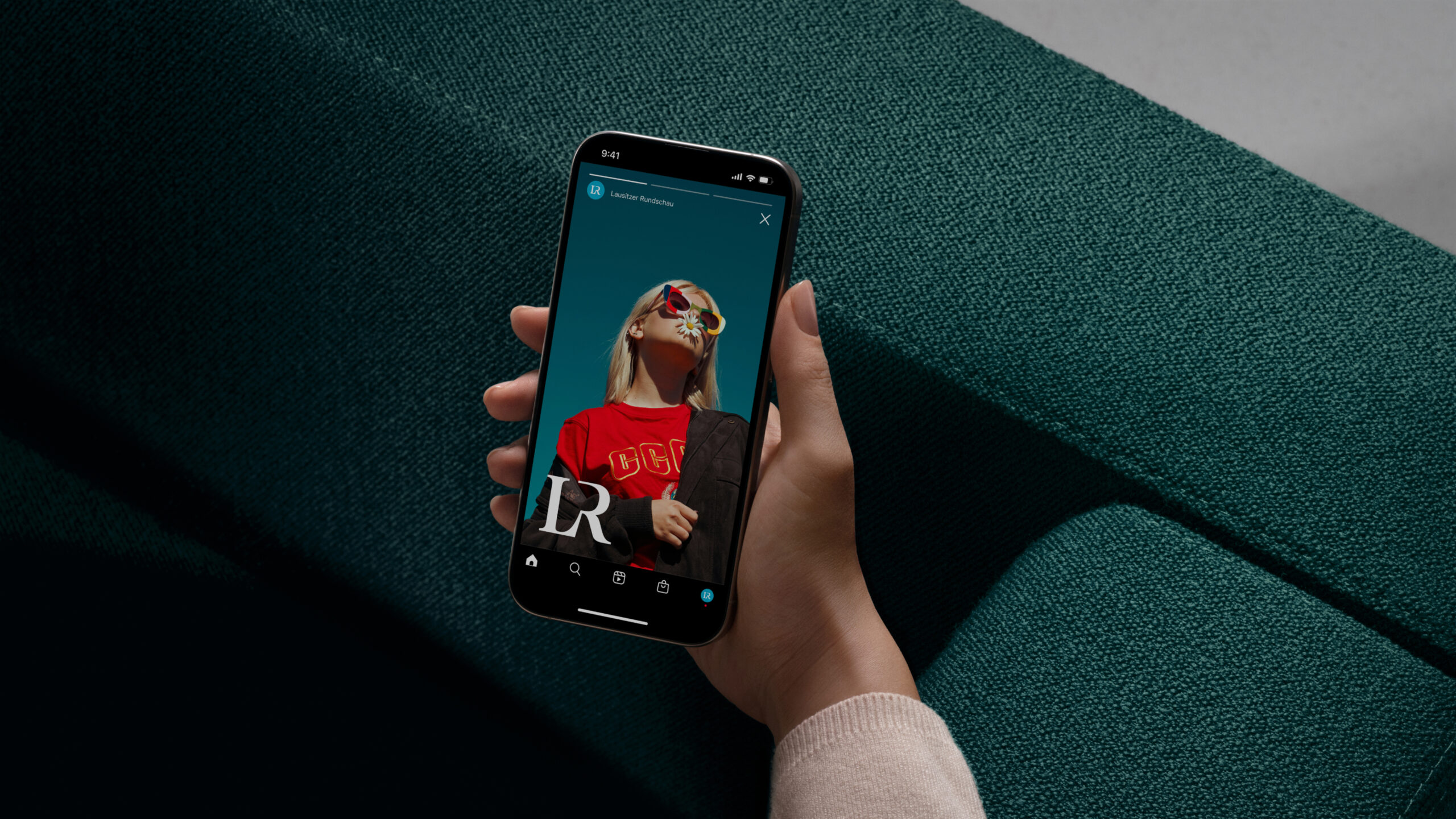
Ready to rebrand? Ask yourself these 7 questions
19. April 2023
Daniel Albert
This article aims to demystify the process and outline the 7 key questions any business should ask themselves before embarking on a rebrand. By answering these key questions, you can shape internal discussions to ultimately decide on whether a rebrand can bring value to your company – and if so, what kind of rebranding would best suit your needs.
Talking about rebranding is hard. As a brand or marketing manager, you often encounter the same kind of questions:
What’s the ROI of branding?
Don’t we have a product problem rather than a brand problem?
Why change the brand? Our brand works fine.
To further complicate things, it’s often unclear what is meant by rebranding. It can range from a light re-touch to a complete brand overhaul which poses a challenge for B2C and B2B brands alike.
This article takes a deep dives into the top 7 questions you should be asking yourself:
- Do customers understand our brand offering?
- Do customers understand who we are?
- Does our brand support our new strategy?
- Does our brand create a smooth customer experience?
- Do we have a strong market position?
- Is our brand fit for the next generation?
- Are people proud to work at our company?
Question 01
Do customers understand our brand offering?
The number one indicator that it’s time for a rebrand is realising that your current or prospective customers don’t understand what you offer. If your product or service offering isn’t clear, you lose money. It’s as simple as that. We’ve all had experience of visiting a landing page and deciding that ‘this isn’t for me’. Each time this happens, a customer is lost. Let’s look at some of the common brand problems that prevent customers from having a clear idea of what you offer.
Key takeaways:
- Avoid information overload
- Stay away from feature fireworks
- Be aware of brand debt
- Don’t be a schizophrenic brand
- Make sure your brand doesn’t suffer from novelty myopia
Information overload
The global attention span is narrowing. And so is the patience of your customers. Your brand’s job is to slice and dice key information, and deliver the right message to the right customer segments. Especially tech-enabled companies often fall prey to ‘feature fireworks’. They talk about their product functionalities in random and quick succession, resulting in more of a fizzle than a bang. The core of your messaging should be on the problem you solve and the value that you add. In a world of information saturation, less is more. And relevance is fundamental.
Brand debt
Most of us have heard of the perils of ‘tech debt’ – when useless pieces of code accumulate over time ultimately slowing down software products. The same exists for brands. As business priorities change over time, brand assets can quickly become out of date. Historic brand assets quickly become out of sync with customer preferences, behaviours and habits and obscure the meaning of your message.
Brand schizophrenia
Both established companies and newcomers to the market can experience brand schizophrenia, where contradictory messaging makes for a confusing customer experience. The sheer amount of brand assets in established companies makes aligning communications a challenge. Newcomers have the opposite challenge, experimenting with different messaging in order to optimise their product-market fit. Branding is more than just what you say – your visual identity and feel needs to match in order to appear authentic and gain customer trust. For example, when you promise “we are a market leader dedicated to the highest quality” you need to make sure your brand looks like “the highest quality”, too.
Novelty myopia
Newcomer companies can fall prey to novelty myopia – the idea that it’s enough to tell customers that they are going where no company has gone before. Sometimes it’s exploring a new market, sometimes it’s creating a new product. Rarely it’s both. But what’s for sure is that just being ‘new and different’ is a lousy competitive advantage – and has been for a long time now. Customers care more about their needs being served than the novelty of a product or service. By default they are unfamiliar with what you do, so double down on your brand and make the value proposition crystal clear.
Task 1 – Dig deeper into your brand’s offering:
- Does our brand voice speak to our customers’ needs?
- Do we have a low conversion rate at key touch points?
- Does our brand send contradicting messages?
- Are our verbal messages aligned with the brand’s look and feel?
- Does our sales team have difficulties getting ‘the message’ across?
Question 02
Do customers understand who we are?
In the section above we highlighted how important it is that customers understand what you do. But that’s only half the battle. Your customers also need to understand who you are in order to decide whether it’s you that they’re looking for.
Key Takeaways:
- Your brand identity is part of your customers’ identity
- Identity matters ever more in the age of Google
- Your brand lives in the minds of your customers
Your brand identity is part of your customers’ identity
According to anthropologist Roland Barthes, the world is not divided into subjects and objects. Or, in our case, people and products. In the world today, we are what we consume. Brand identity is therefore fundamental to customer identity. Solving a customer’s problem is one thing. But are you ready to become part of their identity? Businesses today should understand the responsibility that comes with this opportunity.
Identity matters in the age of Google
As the world has changed over the years so has the role of branding. Before WWII, when consumption was shaped by scarcity, simply providing the product was enough. After WWII, post-war consumption created abundance meaning brands had to fight to stand out on the supermarket shelves. In the hyperconnected world of Google today, consumers have both abundance and access. Today finding a value-fit is the most important consumer trend. Ask yourself – would I rather buy something that just solves my problem, or something that solves my problem and feels like it’s designed for me?
Your brand lives in the minds of your audience
“A brand is not what you say it is. It’s what they – the customers – say it is”. According to brand mogul Marty Neumeier, brands live in the minds of customers. Branding is like reputation. More than just products or services, it’s the sum of everything a company publicly communicates. Customers construct an image based on everything from product, to culture and people. Brands live in the minds of your audience – and they ultimately decide whether that is aligned to the way they see themselves.
It’s your brand’s job to create the reputation you want to have. Your brand has a broad range of mediums to convey this message – and every medium is a chance for you to show who you are.
Task 2 – Dig deeper into your brands’ identity:
- Do our customers know who we are?
- Are we ready to become part of our customers’ identity?
- Would our customers recommend our product to their friends?
- Is our brand a value-fit for our target audience?
- Is our self-perception aligned to how our customers see us?
Question 03
Does our brand support our new strategy?
A rebranding process is a useful tool to support your company in implementing a new strategy or reaching a new chapter.
Key takeaways:
- New positioning requires new branding
- Mergers and acquisitions call for rebranding
- Crisis rebranding must be supported by actions
- Reevaluate your brand before growing internationally
New positioning requires new branding
Are you looking to target a new customer segment? Or deliver a new value proposition? If the answer is yes, then you’re about to embark on a new market positioning. And with this new strategy comes the need to ensure that customers, new or old, intuitively feel that you’re the right fit for them. Rebranding is a way to ensure the success of new market positioning. But it does not necessarily require a complete overhaul. Adjusting assets and transforming your brand on-the-go is a legitimate approach.
Mergers and acquisitions call for rebranding
Mergers and acquisitions are a typical cause for rebranding. But which brand should be the dominant one in the future? And which one should disappear? Or should you merge both brand names? Brand architecture is fundamental to understand in this scenario. There is no one-size-fits all solution. But exploring a rebrand allows you to explore your commonalities, whilst still acknowledging your differences.
Rebranding in the wake of a crisis
Actions speak louder than words – which is why some say that rebranding in the wake of a crisis is like putting lipstick on a pig. But when this rebrand is backed by a clear strategic turn and actionable intentions, it can be immensely powerful. Today you’re measured by the delta of what you say and what you do. If both actions and intentions are aligned, a post-crisis rebrand can signal a new chapter for a company.
Growing your brand internationally
Brands are cultural phenomena – and cultures vary across the world. When expanding into a new market, it’s essential to do the translation work and figure out values and meaning within this audience. What meaning does your brand name and slogan have in this market? Do they make sense in their language and cultural context? If your business is to succeed internationally, you must speak to each market as if they are the only ones in the room.
Task 3 – Dig deeper into what your brand can do for your new strategy:
- Are we targeting a new target customer segment?
- Are we addressing new client needs?
- Has our value proposition changed?
- Are we in the process of an M&A?
- Are we in the wake of a crisis?
- Are we ‘going international’?
Question 04
Does our brand create a smooth customer experience?
Mapping the customer engagement with your brand from A-Z can give you a clear overview of touchpoints, and help you optimise each of these touchpoints.
Key takeways:
- Your brand powers your entire customer journey
- Each touchpoint needs to serve a purpose
- Branding is how it works
Rebranding along the customer journey
Each and every experience your customer has with your brand influences the overall image they have of you. This image goes far beyond classic brand assets such as logo and typography – it begins with the first customer contact. This could be ads, seeing your product in a web-shop, or an organic visit to your website. This customer journey spans from early engagement, to decision-making and purchasing, to the service phase. Put yourself in their shoes. What does this journey look like? How does it feel? Why would they be incentivized to buy again?
Branding is more than how it looks – it’s how it works
“Design is not just what it looks and feels like – it’s how it works”. As Steve Jobs drew attention to the importance of design, so we should too towards branding. Branding is not just what it looks and feels like – it’s how it works. Move beyond talking about logos and typography, and instead look at the functional experience of the customers through different touchpoints. Does this ad speak to the customer? Does this webpage feel relevant to them? Does ‘thank you for your purchase’ email serve its purpose? Once you’ve identified the touch points that don’t work, you can start tweaking this brand engagement to create a better customer experience.
Task 4 – Dig deeper into your brand experience:
- What brand experiences are we creating along the customer journey?
- How can we improve pre-sale experiences?
- How can we improve purchase experiences?
- How can we improve post-sale experiences?
Question 05
Do we have a strong market position?
Key Takeaways:
- Use your brand to double down on your cost-leadership
- Use your brand to double down on your best-in-class strategy
- Use your brand as a tool to make a difference in your customers’ lives
Align your brand with your market position
Corporate strategy expert Michael Porter argued that profitable companies follow one of two strategies: cost-leadership or differentiation. Those who try to do both end up stuck in the middle and lose out on profitability. On a cost-leadership level, they are neither cheap enough, nor target a big enough market share. On the differentiation level, they are unable to succeed in niches as their offering is not bespoke. A distinctive market position is essential for profitability. Whatever strategy you choose for your company, it’s your brand’s job to communicate this position with impact.
If you go for cost-leadership, make sure your customers understand that you provide the biggest bang for their buck. Many supermarket chains follow this principle for their private label brand. Though they may be made by the same producers of premium brands, their branding is designed to feel and look less premium in order to justify the lower cost.
If you go for a differentiated positioning, make sure your customers understand that you’re a specialist in the field – and why. Your brand assets must be streamlined around a narrative of you being the ‘best-in-class’ for that specific customer. This way your brand can gain the favour of an entire market niche.
Brands connect and differentiate at the same time
As social beings, we continuously seek to both connect to one another and differentiate ourselves from each other. By deciding what jobs we do, which people we surround ourselves with and what consume, we are in a constant process of identity formation. Early sociologist Edmund Husseri discovered back in 1906, that identity formation relies as much on stating ‘I am like x’, as it does on stating that ‘I am different from y’.
Where a business approach shows us why it’s important to follow a market differentiation strategy, a sociologist approach shows us how to implement this differentiation strategy – you differentiate by allowing your customers to differentiate for themselves. If you offer B2B services and products, by helping your customer to meet their personal goals, succeed in their organisation and advance their career you are allowing them to differentiate. If you offer B2C products or services, by saving consumers time or offering more sustainable solutions you allow them to make a statement about themselves. Consumers are thereby able to send social signals in purchasing your product. Whichever differentiation strategy you choose, your brand needs to effectively communicate the difference they make.
Task 5 – Dig deeper into how your brand can strengthen your market position:
- Does our brand support a cost leadership strategy?
- Does our brand support a best-in-class strategy?
- Does our brand help our users to be more successful?
- Does our brand help our customers to understand what difference we make in their lives?
- Does our brand enable social signalling?
Question 06
Is our brand fit for the next generation?
Your company’s future success depends on its success in engaging future generations. Use your brand to connect with them today.
Key Takeways:
- The next gen are digital natives
- Design is no longer a nice-to-have
- The future is value-driven
The next gen are digital natives
The next generation are digital natives. This is not news yet still many companies – especially established SMEs – fail to provide digital experiences. Let’s take an extreme example. For many companies in Germany, the fax is still indispensable. As a result, the digital gap is massive. Can you imagine someone from Gen Z – born between 1995 and 2010 – sending you a fax?
Digital should be seen as an extension of your current offerings.
You don’t have to bring your entire business model online, but part of your business should be operational in the digital sphere. For example, even if product or service offering remains in the physical world, the entire customer journey can be facilitated through digital touchpoints.
If your future consumer group includes the next generation, you need to ensure your brand experience is not like in this video of Gen Zers wondering about how to listen to cassette tapes.
Design is no longer a nice-to-have
The state of the internet today is visual. As a result, Gen Zers are not only digital natives but also design natives. As Gen Zers grew up on the design-centred products of Apple and IOS, design is now not a nice-to-have but a need-to-have. If you are to win the hearts and purchasing power of the next generation, brand design must be front and centre of your product. A study from American Express showed that Gen Zers are more likely than previous generations to quit your brand due to “minuscule” design fails such as poorly designed mobile features.
The future is value-driven
A study showed that 77% of Gen Zers want to buy from brands that align with their values. As Gen Z is about to grow into leadership roles and increase their purchasing power, it is essential for brands to clearly communicate the values that they stand for. Brands who successfully connect with this target group will gain a competitive advantage.
Task 6 – Dig deeper into whether your brand is fit for the next generation:
- Does our brand appeal to the digital competencies of our younger customers?
- Which customer experiences can we make digital?
- Does our brand live up to the design standards that younger audiences demand?
- Does our brand enable our customers to connect with us on a value level?
Question 07
Are people proud to work at our company?
In business, people and talent are the key to success. Good people build good products and services. Good products and services perform better in the market. Better performance means a better bottom line. Branding can help companies to attract and retain talent, and gain this competitive advantage.
Key Takeaways:
- Strong brands attract top talent
- Bad brands pose a monetary risk to you as an employer
- Strong brands create employee loyalty
Strong brands attract top talent
A strong employer brand is a competitive edge when attracting talent, especially for companies which cannot compete on a salary level. In these cases, other incentives need to be provided – your brand mission is one of these. A well-known example of this is the collaboration between National Instruments – a producer of scientific testing tools – and Lego. By placing science in the context of play and education, National Instruments showed how much they care about their mission. A strong employer brand creates buy-in where employees become evangelists and spread the word. However, the same happens when an employee has a negative image of a company. A study showed that 75% of Americans would not take a job with a company that had a bad reputation, even if they were unemployed. That has financial consequences. A bad reputation costs a company 10% more per hire. The least you need to do is to ensure that your brand does not pose a risk to your success as an employer.
Strong brands have lower talent turnover
Your employer branding does not only help you to attract the best talent, but also to retain it. According to a study by LinkedIn great employer brands have 28% lower turnover in their organisations. Lower turnover means you have more time to develop your staff and incur less costs of training new talent. National Instruments, for example, boasts a 50% lower turnover rate than the industry average. Thinking about employee satisfaction from a brand perspective helps you to take a holistic view on your employee lifecycle. Map out all the touchpoints your employees experience at your company to identify pain points and to optimise positive experiences. This way you can ensure that they’ll stay and spread the word about your company being a good place to work.
Task 7 – Dig deeper into your employer brand:
- Do we attract top talent?
- Is there word-of-mouth marketing about us as an employer?
- Do our employees have buy-in to the company mission?
- How does our employee turnover compare to the industry average?
Conclusion
It’s possible to structure and shape your internal discussions around rebranding. By asking yourself the seven key questions about rebranding, you can ultimately decide on whether rebranding can bring value to your company – and if so, what kind of rebranding would best suit your needs.
Your next steps to successfully tackle rebranding:
Step 1:
Work through the rebranding cheat sheet
The cheat sheet helps you to tackle rebranding in a structured way – as a checklist or in workshop.
Step 2:
Book a call
Done working through the cheat sheet? Discuss your results with us in a 30-minute strategy session:
- Analysis of your brand bottlenecks
- Identification of solutions
- Prioritisation of possible actions


